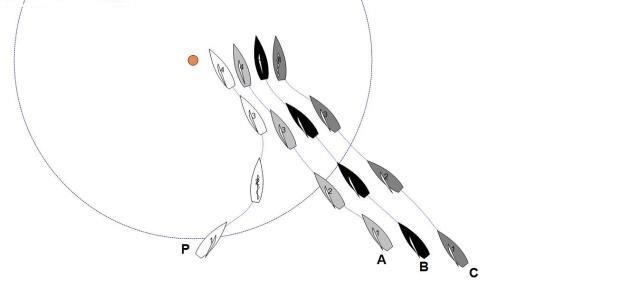


Section B – Boat on boat
RS CALL B2
Rule 11, On the Same Tack, Overlapped
Rule 13, While Tacking
Rule 15, Acquiring Right of Way
Rule 18.3, Passing Head to Wind in the Zone
Rule 43.1(b), Exoneration
Rule E4.3, Taking a Penalty
When a boat in the zone of a mark to be left to port passes head to wind from port
to starboard and is then fetching the mark, her obligations under rule 18.3 apply
between her and all other boats that have been on starboard since entering the
zone.
When a boat has gained an advantage by her breach of a rule despite taking a
penalty, she shall take additional One-Turn Penalties until her advantage is lost.
Assumed Facts
At a windward mark to be left to port, P enters the zone on port, luffs, passes head
to wind and bears away onto a close-hauled course to leeward of A. B and C are
both overlapped to windward of A. A, B and C are all on starboard as they enter
the zone.
A avoids P by luffing. B luffs to windward of both P and A. C luffs to windward
of B and, in doing so, sails above a close-hauled course.

Question 1
Which rules apply?
Answer 1
When P passed head to wind from port to starboard rule 18.3 applies and rule 18.2
does not. As P is not entitled to mark-room rule 43.1(b), exoneration, does not
apply.
Until P reached a close-hauled course, rule 13 applied and she was obliged to keep
clear of A, B and C. When P reached a close hauled course she was overlapped to
leeward of A, B and C, and acquires right of way. P is required under rule 15,
initially, to give A, B and C room to keep clear and she does so.
However, C was obliged to luff above close-hauled to avoid contact with B, who
was obliged to luff to avoid A, who luffed to avoid P. Thus, P caused C to sail
above close-hauled when taking avoiding action. P broke rule 18.3 and should
take a penalty.
Question 2
Having taken a One-Turn Penalty, P is still some distance ahead of B and C.
Should P take an additional One-Turn Penalty?
Answer 2
P is ahead of B and C as a consequence of breaking rule 18.3, P has gained an
advantage in the heat by her breach, despite taking a penalty. P should take
additional One-Turn Penalties until her advantage is lost, as required by rule
E4.3(b). Therefore, the applicable penalty for her breach of rule 18.3 may be to
take multiple turns. See also Call P4.
However, penalty turns are not an applicable penalty for some breaches through
which a boat gained an advantage. Under rule E4.3(c), when a boat causes serious
damage or, by breaking a rule of Part 2, she causes another boat to become
disabled (as defined in rule E1.1) and retire, her penalty shall be to retire.






